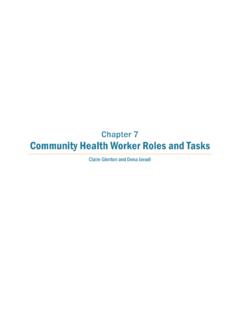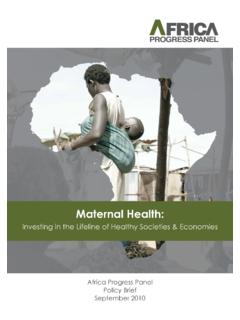Transcription of Integrated Management of Childhood Illness (IMCI)
1 Opportunities for Africa s Newborns 91 Every year, nearly 11 million children die before reaching their fifth response to this challenge,WHO and UNICEF in the early 1990s developed IntegratedManagement of Childhood Illness (IMCI), a strategy designed to reduce child mortality andmorbidity in developing approach focuses on the major causes of deaths inchildren through improving case Management skills of health workers, strengthening thehealth system, and addressing family and community practices. However, the original IMCI modules did not include care of the sick newborn during the first week of life, the time whenone in three child deaths occur, and it did not emphasise home-based newborn has become a main child survival strategy in almost all countries in the African region,creating a unique opportunity to scale up newborn health interventions using IMCI as avehicle. Incorporating newborn algorithms in IMCI and strengthening the components of thestrategy related to the health system and community will directly impact newborn of this work has already begun as generic IMCI guidelines and training materials havebeen revised to include the first week of life.
2 Many countries in Africa are planning to adaptIMCI to include the missing aspects of newborn care. Questions about adapting IMCI inAfrica remain, however. For example, should routine home visits for postnatalcare in the first week of life be included in the IMCI strategy? Should IMCI include care at the time of birth? Should IMCI training start withmanagement of young infants (0-2 months) rather than older infants andchildren? What are the challenges in implementing IMCI in an effectiveway? How can complementary facility-based and community-basedapproaches be combined? Many lessons can be gained from countries,especially in Asia, where IMCI has already been adapted to IntegratedManagement of Childhood and Neonatal Illness (IMNCI). Integrated Management of Childhood Illness (IMCI)Tigest Ketsela, Phanuel Habimana, Jose Martines, Andrew Mbewe, Abimbola Williams,Jesca Nsungwa Sabiiti, Aboubacry Thiam, Indira Narayanan, Rajiv Bahl CHAPTER 5 III92 Opportunities for Africa s NewbornsThe IMCI packageThe Integrated Management of Childhood Illness (IMCI) strategy is central to the achievement of childsurvival and development, a key principle of theConvention on the Rights of the child .
3 The strategy isbased on human rights that guarantee health care to allchildren, no matter where they live, and is implementedby addressing the gaps in knowledge, skill, andcommunity practices regarding children s health ,recognition of Illness , home Management of the sickchild, and appropriate careseeking behaviour. The IMCI strategy includes three important components:1. Integrated Management of ill children in facilities andhealth centres2. health system strengthening, particularly drugs andlogistics support3. Community IMCI, or promotion of key family andcommunity practicesThe three components of the IMCI strategy are mosteffective when they are implemented simultaneously. Forexample, IMCI training to improve the skills of healthworkers for better case Management in health facilities,accompanied by health systems strengthening efforts,such as improving the supply of essential drugs, resultedin a 13 percent reduction in under-five mortality in twoyears in Bangladesh, home care for illnessand timely careseeking improved through communityIMCI (C-IMCI), while IMCI training increased qualityof care at the health facilities.
4 This combination ofcommunity and health facility approaches resulted insubstantial increases in the use of the effect on survival of interventions in thethree IMCI problemFigure child survivalthrough the three components of IMCIThe health of children is closely linked to the health and care of their mothers. As the newborn growsinto a child , healthy home behaviours and care of illnesses are crucial to save lives. Lack of care, orpoor quality care, has effects for newborns and children:Effects on newborns:Every year million African babies die in the first month of life and theleading cause is majority of the estimated 325,000 babies who die from neonatal sepsisand pneumonia could be saved with simple preventive practices such as clean skin and cord care,breastfeeding and warmth, and better Management of those who are sick, especially using newborn deaths are among low birthweight (LBW) babies, or babies weighing less than 2500grams at birth.
5 Simple care of all small babies and early treatment of complications would save manynewborn lives. However, neither home care practices nor care of small babies, or even treatment ofnewborn infections have been systematically addressed by child health programmes at scale, includingIntegrated Management of Childhood Illness (IMCI).Effects on children:Lack of health promotion and services for babies has an impact on older childrentoo. Severe Illness during the first month of life can result in long term disability and poor schoolperformance but there is little concrete data available on these serious newborn illnesses and theirlong-term effects on first weeks of life are crucial for establishing healthy behaviours, suchas breastfeeding in Africa only one third of babies under 6 months of age are exclusively : References5;6 Reproduced with permission of WHOO pportunities for Africa s Newborns 93 IIIIMCI functions best when families and communities arelinked to the first level facility which in turn links well tothe referral level.
6 (Figure ) This is the sameprinciple that is set out in Section II regarding theimportance of a seamless continuum of care across healthservice delivery case Management at first level health facility, referral level, and homeTable of interventions currently included in the IMCI strategyIMCI combines prevention and care, focusing on thechild and not only on the individual diseases. The typesof interventions currently in the IMCI strategy are shownin Table : Adapted from references 5;6 LEVELTYPES OF INTERVENTIONI llness prevention and growth promotionResponse to Illness (curative care)Home and communityHealthServices Community/home-based promotion ofappropriate infant feeding practices; peercounselling for breastfeeding andcomplementary feeding Use of insecticide treated bednets Appropriate infection control practices Vaccinations Micronutrient supplementation health worker counselling for breastfeedingand appropriate complementary feeding Early recognition and home Management of Illness Appropriate care seeking Adherence to treatment recommendations Case Management of acute respiratoryinfection diarrhoea, measles, malaria,malnutrition.
7 And other serious infections Counselling on feeding problems Iron for treatment of anaemia Antihelminthic treatmentCLASSIFY child SCONDITIONANDIDENTIFYTREATMENT PINK - PRE-REFERRALTREATMENTANDREFERRALADVISE parents aboutREFERRALEMERGENCY TRIAGEASSESSMENT ANDTREATMENTDIAGNOSE AND TREATCOMMON SERIOUSCONDITIONSMONITOR PATIENT PROGRESSGIVE ORAL DRUGSAND/ORTREAT LOCAL INFECTIONGIVE FOOD AND FLUIDS(follow feedingrecommendations)RETURN TO health FACILITYWHEN NEEDEDTEACH parents abouttreatmentCOUNSEL them about feeding and when toreturnGive FOLLOW-UPcare when the child returns, and if necessary,reassess for new problemsAsk about child S PROBLEMSC heck for GENERAL DANGER SIGNSASSESS for MAIN SYMPTOMS:COUGH OR DIFFICULTBREATHING DIARRHOEAFEVERC heck for OTHER PROBLEMSASSESS forMALNUTRITION AND ANAEMIA YELLOW -SPECIFICTREATMENT ATFIRST LEVELFACILITY GREEN - HOMEMANAGEMENTFIRST LEVEL health FACILITYREFERRAL LEVELHOME AND FAMILY94 Opportunities for Africa s NewbornsCurrent coverage of IMCIIMCI is currently being implemented in more than 100countries throughout the world.
8 , As of June 2006, 44 of46 sub-Saharan African countries in sub-Saharan Africaare in various phases of IMCI implementation, with 27expanding beyond a few initial implementation of these 27 countries are carrying out thestrategy in more than 50 percent of their districts (Figure ).IMCI implementation has been evaluated through twolarge efforts: the Analytic Review of IMCI7 and theMulti-Country ;6 These reports have foundthat IMCI training substantially improves the quality ofcare in health ;8-10 Still, while some countrieshave reached high coverage, most countries haveprogressed much more slowly than initially focus of IMCI strategy in many countries has beenmore on health worker training than the balance of allthree components. Where more than one of the threeIMCI components were advanced together, however, as inTanzania and Bangladesh, faster progress was made inimproving child ;11 Opportunities to strengthen newborncare within IMCIW hile prioritising the main causes of child mortality, theoriginal generic IMCI guidelines missed two major causesof neonatal deaths during the first week of life asphyxiaand preterm birth.
9 The young infant IMCI algorithmsonly addressed prevention and Management of infectionsafter the first week of life because information on theperformance of simple clinical signs of Illness in thisperiod has only recently become ;13 When thealgorithms were originally developed, it was consideredthat care around the time of birth and the first week were to be mainly addressed through maternal careprogrammes, although in reality newborn care falls in thegap between maternal and child care , in IMCI implementation the emphasis has beenon delivering interventions through the formal healthcare system. However, many of the simplest first steps tosave newborn lives require delivery approaches that arecommunity based. The key family and communitypractices originally identified in the IMCI strategy didnot focus on newborn care practices such as earlyinitiation of breastfeeding and thermal the newborn interventions in eachcomponent of IMCI would contribute to saving manynewborn lives, and would also benefit IMCI itselfthrough further integration of the three components ofthe IMCI strategy.
10 In this way, IMCI programmes canstrengthen the continuum of care by promoting activitiesthat enhance newborn care practices within the familyand providing support to vulnerable newborns. Inparticular this applies to providing care for LBW babies,identifying newborns with signs of severe Illness andfacilitating timely referral, and improving the quality ofcare for newborn Illness at primary and referral carefacilities. Follow-up of babies with problems identifiedbecause of a maternal condition, such as syphilis or HIVinfection, would also become a priority of child healthworkers as a result of improved hand-over betweenmaternal and child health services. Case Management of Illness in first level healthfacilities opportunities to include newborninterventions The first and most effectively implemented component ofIMCI has been the Integrated Management of ill childrenin facilities.













